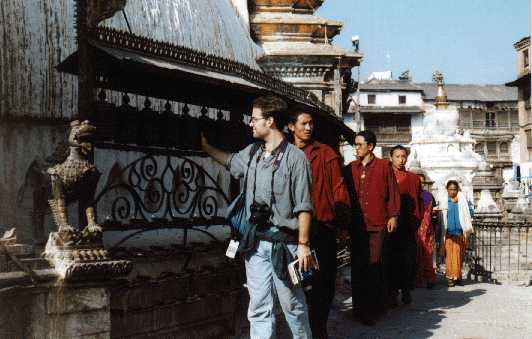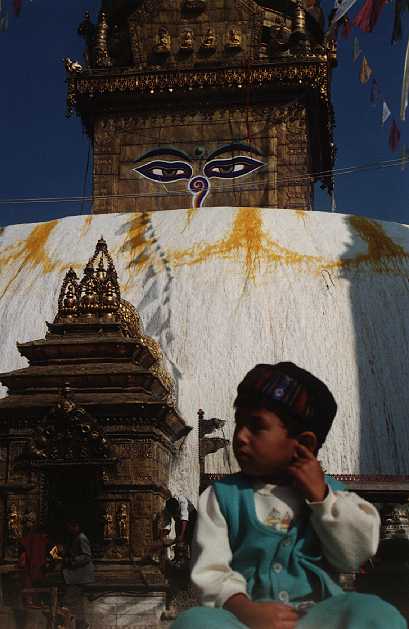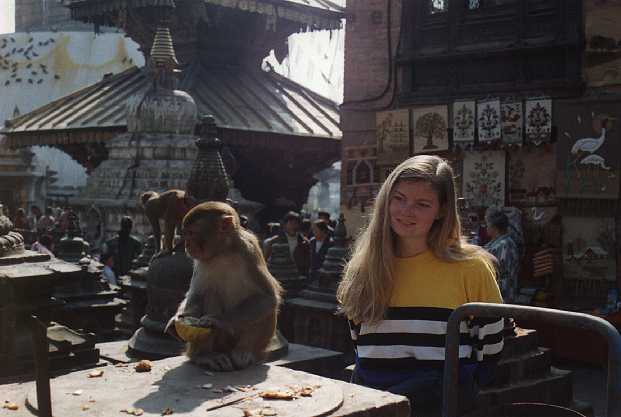
 Saturday, November 16:
Saturday, November 16:We slept til 7am and had breakfast on the roof. It was a hazy morning, so you couldn't see much of the high Himalayan peaks, but the hills that circumscribed the Kathmandu Valley soared and rolled in all directions. We had hot tea, pancakes and eggs - not the usual healthy fare I would swear by at home, but from the amount of running around we were doing, I figured the extra protein and fat wouldn't kill us. Besides, I already needed to pull into my next belt notch just to keep my pants from falling off. Ah, the side effects of third world travel.
Our first goal of the day was to climb Swayumbunath, the great Buddhist stupa west of the city. For many people, Swayumbunath is the symbol of Kathmandu, with its four sets of eyes peering in all directions. We cut through the main section of Thamel and Chhetrapati, the next neighborhood south, and then headed west over the Vishnumati River. Just before the river we found a small pagoda called the Indrani Temple. It was our first Nepalese pagoda up-close, so it probably got more attention than it deserved. A group of children were wrapping a large banyan tree with yards and yards of string, as if they were having a May Day celebration. We took a few pictures and then continued west for another 15 minutes, as we could see Swayumbunath high up on its hill. The closer we got, the higher it seemed. Man, this was going to be a steep climb.
We were greeted at the base of Swayumbunath hill by several small temple-shrines, as well as artisans, beggars, tourists, autorickshaw-wallahs, and a couple of monkeys. I told Susanne about the 365 steps of Swayumbunath hill - if you can climb to the top without pausing, you'll have a year of good luck. If you stop along the way, well, you don't. But about a quarter of the way up, our ailing bodies reminded us that good health is much more important than good luck, so we used our cameras as an excuse to pause and take some pictures. I tired to get a shot of a monkey as it peacefully ate some fruit. Just as I prepared to snap the pictures, the monkey lunged at me a snarled. I got the shot and got out of its way. Swayumbunath was also known as the Monkey Temple, and its monkeys didn't have a reputation for friendliness. I'd be more cautious from now on.
About 200 feet from the summit, the steps took an extreme increase in attitude. I felt like I had been jogging up Russian Hill in San Francisco. But soon enough, we could see the eyes of Swayumbunath above us. In retrospect, I'm glad my first experience with a Nepalese stupa was right here, high above the Kathmandu Valley. The exhausting ascent made the exhilaration of reaching the top all the more special.
Swayumbunath is a classic Buddhist stupa - a square platform base and a large, white hemispherical body, followed by a square head and a rounded pyramid as a crown. Streamers of prayer flags connected the top of the crown to four smaller shrines that marked off the corners of Swayumbunath, representing the basic elements of earth, water, fire and wind. On the four sides of the head were those mystical eyes of Buddha that make stupas so instantly recognizable. Below each pair of eyes you would see the Nepali number for 'one,' which to most Westerners look like Buddha's nose. And along the round edge of the body, at shoulder level above the platform base, are hundreds of large prayer wheels, each containing thousands of handwritten repetitions of the Buddhist mantra, Om Mani Padme Hum - Hail to the Jewel in the Lotus. As visitors walked around the stupa clockwise (counterclockwise is strictly taboo), they spun the wheels with their hands, emitting the sacred mantra into the ether millions and millions of times.

After pausing to catch our breath and appreciate the moment, we made a semi-circle stroll around the stupa, spinning the wheels as we walked. On the opposite side you could see several hundred people lining up to give pujas to a small shrine of Hariti, the goddess of smallpox and (more importantly) of fertility. Further beyond that were several dozen miniature pagoda shrines of white marble, none larger than a big tombstone, which gave the effect of being at a New Orleans cemetery.
 We spent a couple of hours wandering the stupa platform and the shrines surrounding it, taking pictures of monks, children, monkey, and of course, the stupa. The sun was getting at a perfect height for pictures, so we probably went a little nuts with our cameras - I wouldn't be surprised if Susanne took an entire roll of film of monks. (nothing wrong with that, though the 20 rolls we brought with us may no longer be enough at this rate.) As late morning approached, we decided to head back down the hill and cut southeast over the river towards Durbar Square, the heart of old Kathmandu.
We spent a couple of hours wandering the stupa platform and the shrines surrounding it, taking pictures of monks, children, monkey, and of course, the stupa. The sun was getting at a perfect height for pictures, so we probably went a little nuts with our cameras - I wouldn't be surprised if Susanne took an entire roll of film of monks. (nothing wrong with that, though the 20 rolls we brought with us may no longer be enough at this rate.) As late morning approached, we decided to head back down the hill and cut southeast over the river towards Durbar Square, the heart of old Kathmandu.
 On the way there, we cut through some fairly poor Newari and Tibetan neighborhoods, but even these appeared to be significantly better off than the slums we saw in Delhi and Varanasi. We also met a pair of girls, around 20 years old, both well-dressed and wearing stylish glasses. I figured they were tourists from India. It turns out they were sisters from Kathmandu who were out seeing the sights of their home town. They had a sister at Georgetown and one of them had recently visited her. They certainly stuck out as being very well off, especially by Kathmandu standards. Before they departed our company, I asked what their family did. "We own the Kathmandu Guest House." Assuming they weren't messing with me, that would explain a lot.
On the way there, we cut through some fairly poor Newari and Tibetan neighborhoods, but even these appeared to be significantly better off than the slums we saw in Delhi and Varanasi. We also met a pair of girls, around 20 years old, both well-dressed and wearing stylish glasses. I figured they were tourists from India. It turns out they were sisters from Kathmandu who were out seeing the sights of their home town. They had a sister at Georgetown and one of them had recently visited her. They certainly stuck out as being very well off, especially by Kathmandu standards. Before they departed our company, I asked what their family did. "We own the Kathmandu Guest House." Assuming they weren't messing with me, that would explain a lot.
We crossed a metal footbridge over the Vishnumati river and within a few minutes had reached the southwest corner of Durbar Square. All the major cities in the Kathmandu Valley have what is known as a 'Durbar Square' - a 'durbar' is a palace. Until a couple of centuries ago, the three main cities of the valley - Kathmandu, Patan and Bhaktapur - were all rival cities states, often in a state of war. Because of their self-imposed isolation from each other, each city had its royal family, its palace, and therefore, its own Durbar Square. Kathmandu's Durbar Square is actually a series of interconnecting squares and palaces, filled with countless pagodas, shrines, and shops.
It was odd, wandering among the pagodas for the first time. I felt as if I were in Kyoto or Tokyo, for the architecture is so similar. And for good reason - 500 years ago, architects from Nepal went to Japan to help rebuild after a series of earthquakes, so the Japanese picked up and refined the pagoda style into their own architectural form. But just looking at Kathmandu's great pagodas, like the 13th century wooden shrine of Kasthamandap (which gave Kathmandu its name), you really begin to feel like you're in the Far East. Considering we're due south of China, I guess we are in the Far East. It's just strange thinking about it.
Durbar Square is overpopulated with tourists and touts, so we ducked into a pagoda that appeared to lead to an isolated courtyard. We had stumbled into Kumari Chowk, the courtyard of the Living Goddess Kumari. Quite literally, Kumari is a living goddess, a young girl whose divine reign ends when she reaches puberty. She's kind of like a female Newari Dalai Lama, but without tenure. There have been Kumaris in Kathmandu since the mid-1700s, and their worship is taken very seriously. As we looked around the small, ornate courtyard, a guard called out something in Newari and then said to us, "Look up! I present the Kumari." To our left in a 3rd floor window, the Kumari appeared, sporting a headdress and caked in layers of Kabuki-like makeup. She saw us, appeared totally uninterested, and left the balcony in a matter of three or four seconds. The guard then motioned for us to start clapping and to leave a tip on the courtyard shrine. It's good to be a goddess.
 Our next stop was Nasal Chowk, the old palace of the King of Nepal. King Birendra recently moved into a new palace complex northeast of Thamel, but the old palace was still heavily guarded as if he were still a resident. Also standing watch was a 16th century statue of the monkey god Hanuman, who had been coated in so many layers of red paint that he was hardly recognizable. Most of the palace is off-limits to visitors, so we made due with a brief stop in the coronation courtyard. From there, we continued north through the rest of Durbar Square. On the far end of it, we noticed a sadhu sitting on a shrine. He obviously wanted people to take pictures of him (for baksheesh, of course), as I was more than happy to oblige. I got the shot and gave him a couple of rupees. As I walked away, he mumbled something in Nepali that we imagined must have meant "bloody cheap American tourist."
Our next stop was Nasal Chowk, the old palace of the King of Nepal. King Birendra recently moved into a new palace complex northeast of Thamel, but the old palace was still heavily guarded as if he were still a resident. Also standing watch was a 16th century statue of the monkey god Hanuman, who had been coated in so many layers of red paint that he was hardly recognizable. Most of the palace is off-limits to visitors, so we made due with a brief stop in the coronation courtyard. From there, we continued north through the rest of Durbar Square. On the far end of it, we noticed a sadhu sitting on a shrine. He obviously wanted people to take pictures of him (for baksheesh, of course), as I was more than happy to oblige. I got the shot and gave him a couple of rupees. As I walked away, he mumbled something in Nepali that we imagined must have meant "bloody cheap American tourist."
We continued up through the city back towards Thamel, stopping at the occasional shrine, miniature stupa, or thangka shop. Back at the hotel, we changed clothes and had lunch down the street at Le Bistro, a popular yet overpriced haunt in Thamel. We then browsed some more in Thamel's many shops, and at one point I made the regrettable decision of asking a wandering Nepalese violin salesman how much his instruments cost. 90 US dollars, he said. I laughed. I had no plans to buy it, but I was just curious as to how much he would try to get from us. Bad idea. The man then started to follow us around for about 15 minutes, ranting about how crazy I must be to ask for a price yet not have an interest in buying. If I'm not interested, why ask, right? An insult! The funniest part of it was that while he followed us and bitched at me, his asking price dropped lower and lower. By the time I got him to buzz off, he wanted only 20 dollars for it. Not bad, but no thanks.
Susanne and I returned to the hotel late in the afternoon to write postcards and have tea on the roof. We ended up having an early dinner as well, with Susanne getting her beloved hot and sour soup, while I had a delicious bowl of Tibetan chicken soup with momos, the Tibetan equivalent to steamed wontons. We then headed back to the room, worked on our journals, and relaxed the evening away, apart from a brief trip I took down the street to pick up email from my dad.
Take me back to the journal index.
Take me back to Andy's Waste of Bandwidth.


